Health Workforce Planning: International Migration in Australia Report
VerifiedAdded on 2023/01/16
|12
|2430
|21
Report
AI Summary
This report provides a detailed analysis of health workforce planning in Australia, focusing on the country's reliance on international health worker immigration to meet workforce supply needs. It examines existing government policies, the reasons behind workforce developments, and the sustainability of current practices. The report identifies the impact of international migration, including both positive contributions and negative effects such as pressure on resources and potential exploitation of migrants. It also presents ten recommendations to transform the health workforce, aligning with sustainable development goals (SDGs). The report concludes by emphasizing the importance of addressing workforce shortages and the need for sustainable policies to ensure efficient patient care and healthcare delivery in Australia. The report uses data from various sources, including the AIHW and NMBA and provides references from the last five years.
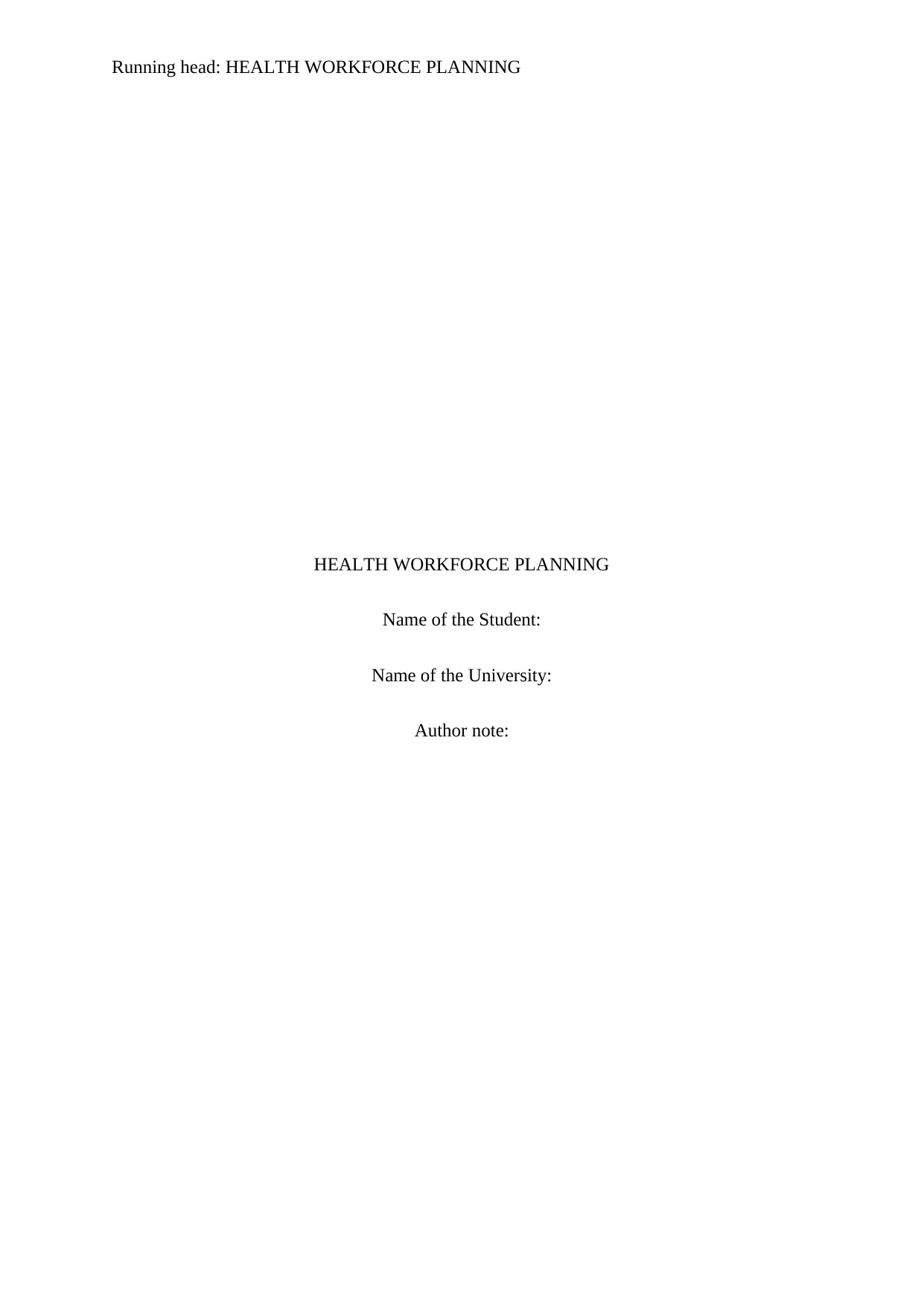
Running head: HEALTH WORKFORCE PLANNING
HEALTH WORKFORCE PLANNING
Name of the Student:
Name of the University:
Author note:
HEALTH WORKFORCE PLANNING
Name of the Student:
Name of the University:
Author note:
Paraphrase This Document
Need a fresh take? Get an instant paraphrase of this document with our AI Paraphraser
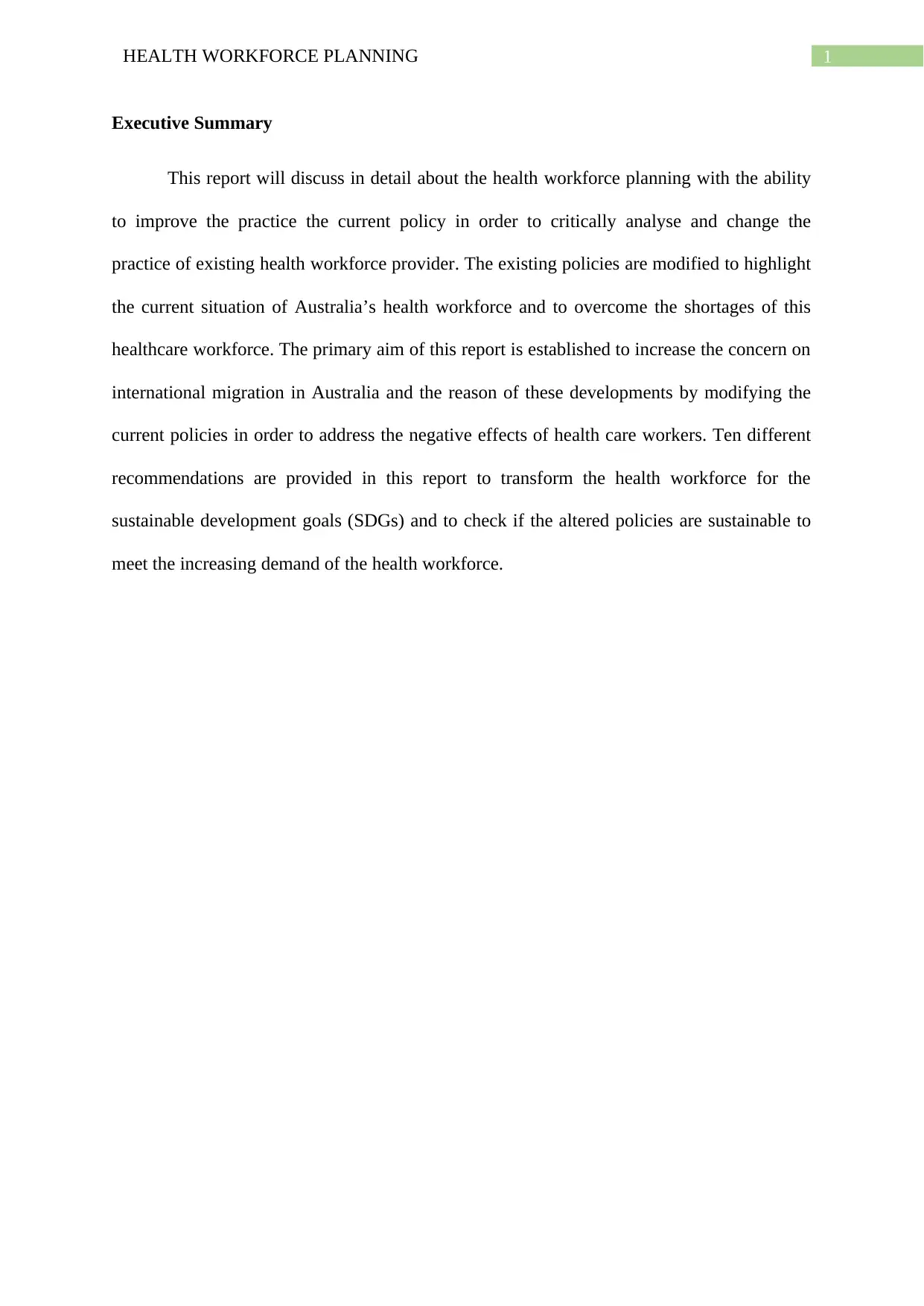
1HEALTH WORKFORCE PLANNING
Executive Summary
This report will discuss in detail about the health workforce planning with the ability
to improve the practice the current policy in order to critically analyse and change the
practice of existing health workforce provider. The existing policies are modified to highlight
the current situation of Australia’s health workforce and to overcome the shortages of this
healthcare workforce. The primary aim of this report is established to increase the concern on
international migration in Australia and the reason of these developments by modifying the
current policies in order to address the negative effects of health care workers. Ten different
recommendations are provided in this report to transform the health workforce for the
sustainable development goals (SDGs) and to check if the altered policies are sustainable to
meet the increasing demand of the health workforce.
Executive Summary
This report will discuss in detail about the health workforce planning with the ability
to improve the practice the current policy in order to critically analyse and change the
practice of existing health workforce provider. The existing policies are modified to highlight
the current situation of Australia’s health workforce and to overcome the shortages of this
healthcare workforce. The primary aim of this report is established to increase the concern on
international migration in Australia and the reason of these developments by modifying the
current policies in order to address the negative effects of health care workers. Ten different
recommendations are provided in this report to transform the health workforce for the
sustainable development goals (SDGs) and to check if the altered policies are sustainable to
meet the increasing demand of the health workforce.
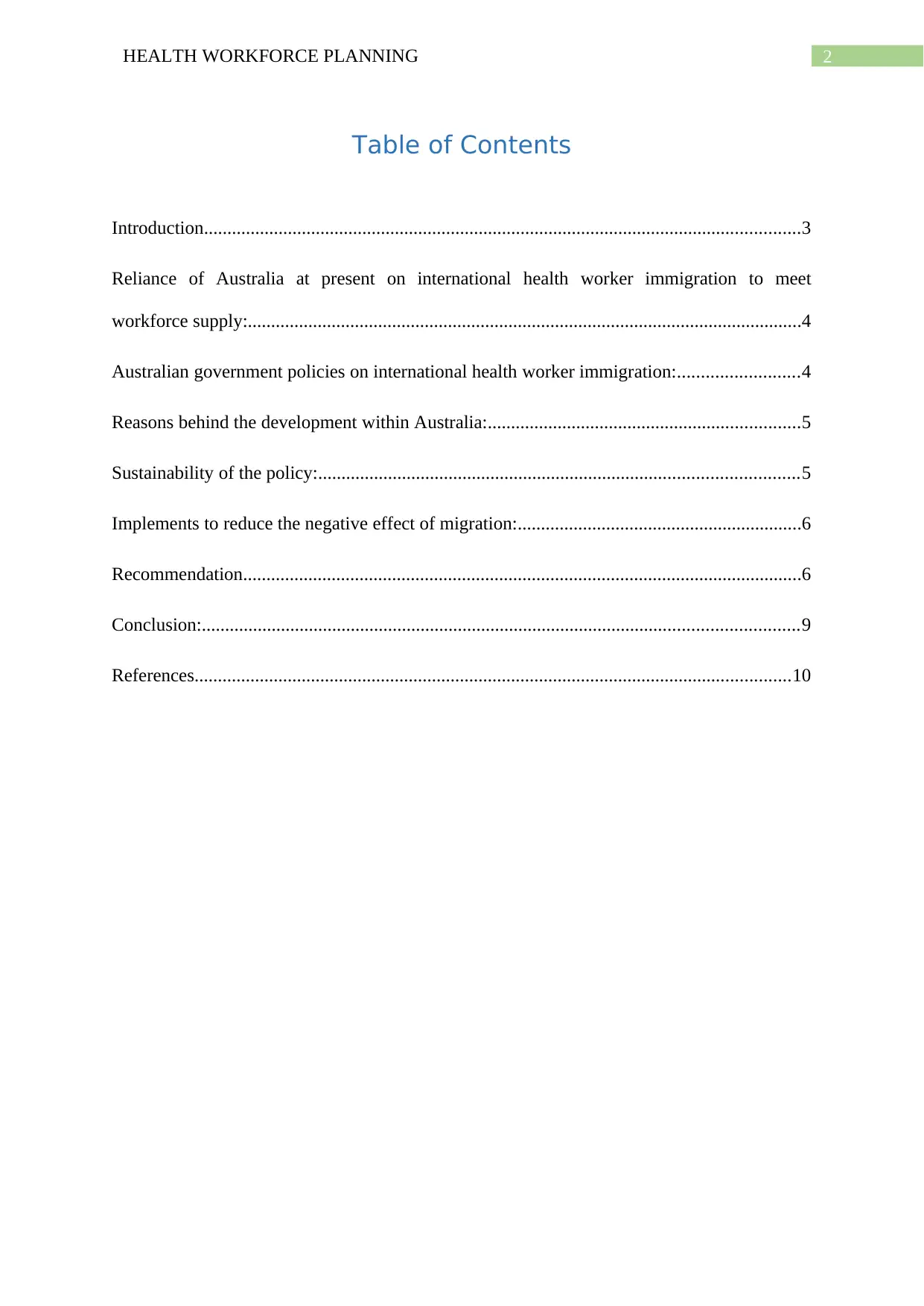
2HEALTH WORKFORCE PLANNING
Table of Contents
Introduction................................................................................................................................3
Reliance of Australia at present on international health worker immigration to meet
workforce supply:.......................................................................................................................4
Australian government policies on international health worker immigration:..........................4
Reasons behind the development within Australia:...................................................................5
Sustainability of the policy:.......................................................................................................5
Implements to reduce the negative effect of migration:.............................................................6
Recommendation........................................................................................................................6
Conclusion:................................................................................................................................9
References................................................................................................................................10
Table of Contents
Introduction................................................................................................................................3
Reliance of Australia at present on international health worker immigration to meet
workforce supply:.......................................................................................................................4
Australian government policies on international health worker immigration:..........................4
Reasons behind the development within Australia:...................................................................5
Sustainability of the policy:.......................................................................................................5
Implements to reduce the negative effect of migration:.............................................................6
Recommendation........................................................................................................................6
Conclusion:................................................................................................................................9
References................................................................................................................................10
⊘ This is a preview!⊘
Do you want full access?
Subscribe today to unlock all pages.

Trusted by 1+ million students worldwide
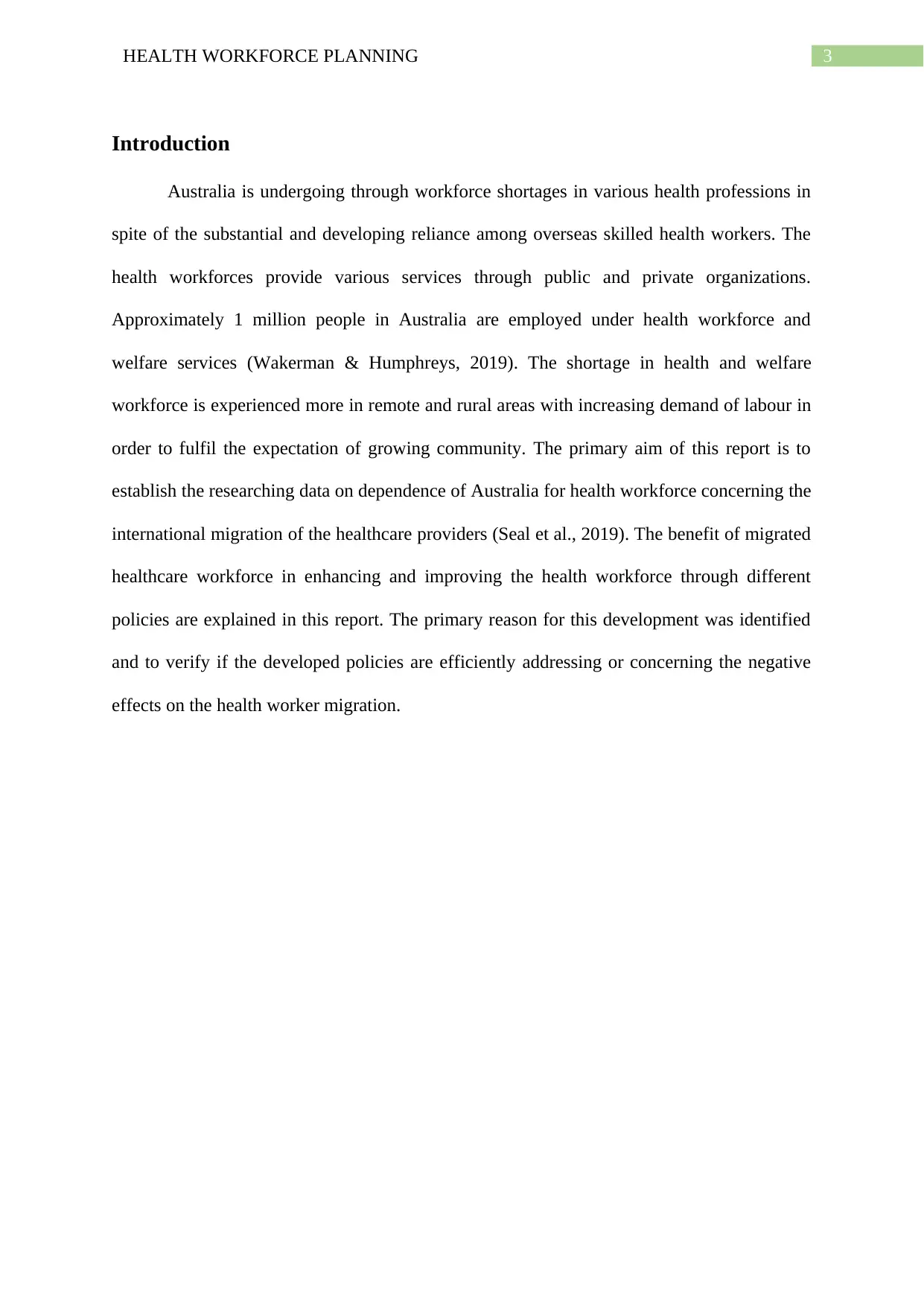
3HEALTH WORKFORCE PLANNING
Introduction
Australia is undergoing through workforce shortages in various health professions in
spite of the substantial and developing reliance among overseas skilled health workers. The
health workforces provide various services through public and private organizations.
Approximately 1 million people in Australia are employed under health workforce and
welfare services (Wakerman & Humphreys, 2019). The shortage in health and welfare
workforce is experienced more in remote and rural areas with increasing demand of labour in
order to fulfil the expectation of growing community. The primary aim of this report is to
establish the researching data on dependence of Australia for health workforce concerning the
international migration of the healthcare providers (Seal et al., 2019). The benefit of migrated
healthcare workforce in enhancing and improving the health workforce through different
policies are explained in this report. The primary reason for this development was identified
and to verify if the developed policies are efficiently addressing or concerning the negative
effects on the health worker migration.
Introduction
Australia is undergoing through workforce shortages in various health professions in
spite of the substantial and developing reliance among overseas skilled health workers. The
health workforces provide various services through public and private organizations.
Approximately 1 million people in Australia are employed under health workforce and
welfare services (Wakerman & Humphreys, 2019). The shortage in health and welfare
workforce is experienced more in remote and rural areas with increasing demand of labour in
order to fulfil the expectation of growing community. The primary aim of this report is to
establish the researching data on dependence of Australia for health workforce concerning the
international migration of the healthcare providers (Seal et al., 2019). The benefit of migrated
healthcare workforce in enhancing and improving the health workforce through different
policies are explained in this report. The primary reason for this development was identified
and to verify if the developed policies are efficiently addressing or concerning the negative
effects on the health worker migration.
Paraphrase This Document
Need a fresh take? Get an instant paraphrase of this document with our AI Paraphraser
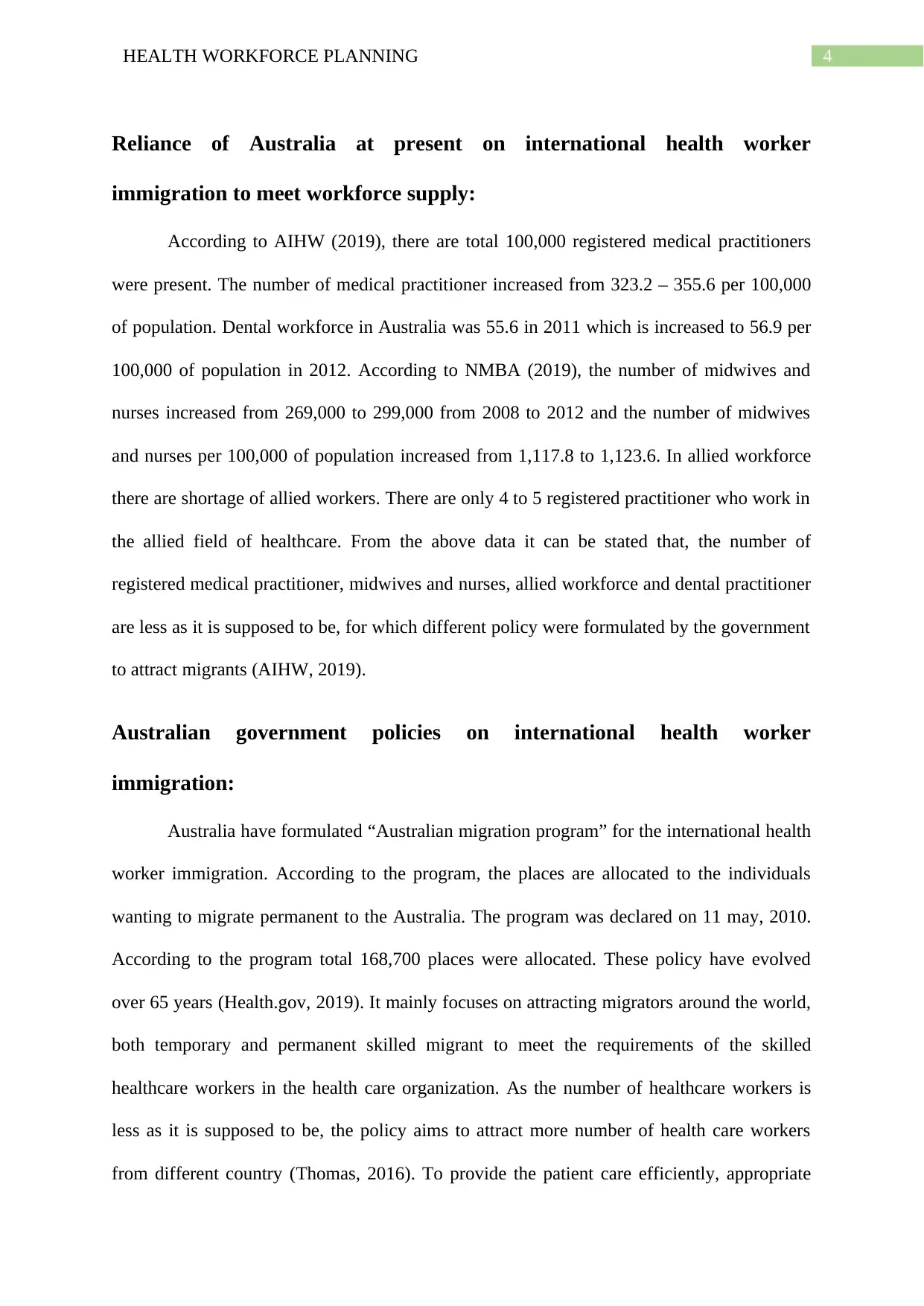
4HEALTH WORKFORCE PLANNING
Reliance of Australia at present on international health worker
immigration to meet workforce supply:
According to AIHW (2019), there are total 100,000 registered medical practitioners
were present. The number of medical practitioner increased from 323.2 – 355.6 per 100,000
of population. Dental workforce in Australia was 55.6 in 2011 which is increased to 56.9 per
100,000 of population in 2012. According to NMBA (2019), the number of midwives and
nurses increased from 269,000 to 299,000 from 2008 to 2012 and the number of midwives
and nurses per 100,000 of population increased from 1,117.8 to 1,123.6. In allied workforce
there are shortage of allied workers. There are only 4 to 5 registered practitioner who work in
the allied field of healthcare. From the above data it can be stated that, the number of
registered medical practitioner, midwives and nurses, allied workforce and dental practitioner
are less as it is supposed to be, for which different policy were formulated by the government
to attract migrants (AIHW, 2019).
Australian government policies on international health worker
immigration:
Australia have formulated “Australian migration program” for the international health
worker immigration. According to the program, the places are allocated to the individuals
wanting to migrate permanent to the Australia. The program was declared on 11 may, 2010.
According to the program total 168,700 places were allocated. These policy have evolved
over 65 years (Health.gov, 2019). It mainly focuses on attracting migrators around the world,
both temporary and permanent skilled migrant to meet the requirements of the skilled
healthcare workers in the health care organization. As the number of healthcare workers is
less as it is supposed to be, the policy aims to attract more number of health care workers
from different country (Thomas, 2016). To provide the patient care efficiently, appropriate
Reliance of Australia at present on international health worker
immigration to meet workforce supply:
According to AIHW (2019), there are total 100,000 registered medical practitioners
were present. The number of medical practitioner increased from 323.2 – 355.6 per 100,000
of population. Dental workforce in Australia was 55.6 in 2011 which is increased to 56.9 per
100,000 of population in 2012. According to NMBA (2019), the number of midwives and
nurses increased from 269,000 to 299,000 from 2008 to 2012 and the number of midwives
and nurses per 100,000 of population increased from 1,117.8 to 1,123.6. In allied workforce
there are shortage of allied workers. There are only 4 to 5 registered practitioner who work in
the allied field of healthcare. From the above data it can be stated that, the number of
registered medical practitioner, midwives and nurses, allied workforce and dental practitioner
are less as it is supposed to be, for which different policy were formulated by the government
to attract migrants (AIHW, 2019).
Australian government policies on international health worker
immigration:
Australia have formulated “Australian migration program” for the international health
worker immigration. According to the program, the places are allocated to the individuals
wanting to migrate permanent to the Australia. The program was declared on 11 may, 2010.
According to the program total 168,700 places were allocated. These policy have evolved
over 65 years (Health.gov, 2019). It mainly focuses on attracting migrators around the world,
both temporary and permanent skilled migrant to meet the requirements of the skilled
healthcare workers in the health care organization. As the number of healthcare workers is
less as it is supposed to be, the policy aims to attract more number of health care workers
from different country (Thomas, 2016). To provide the patient care efficiently, appropriate
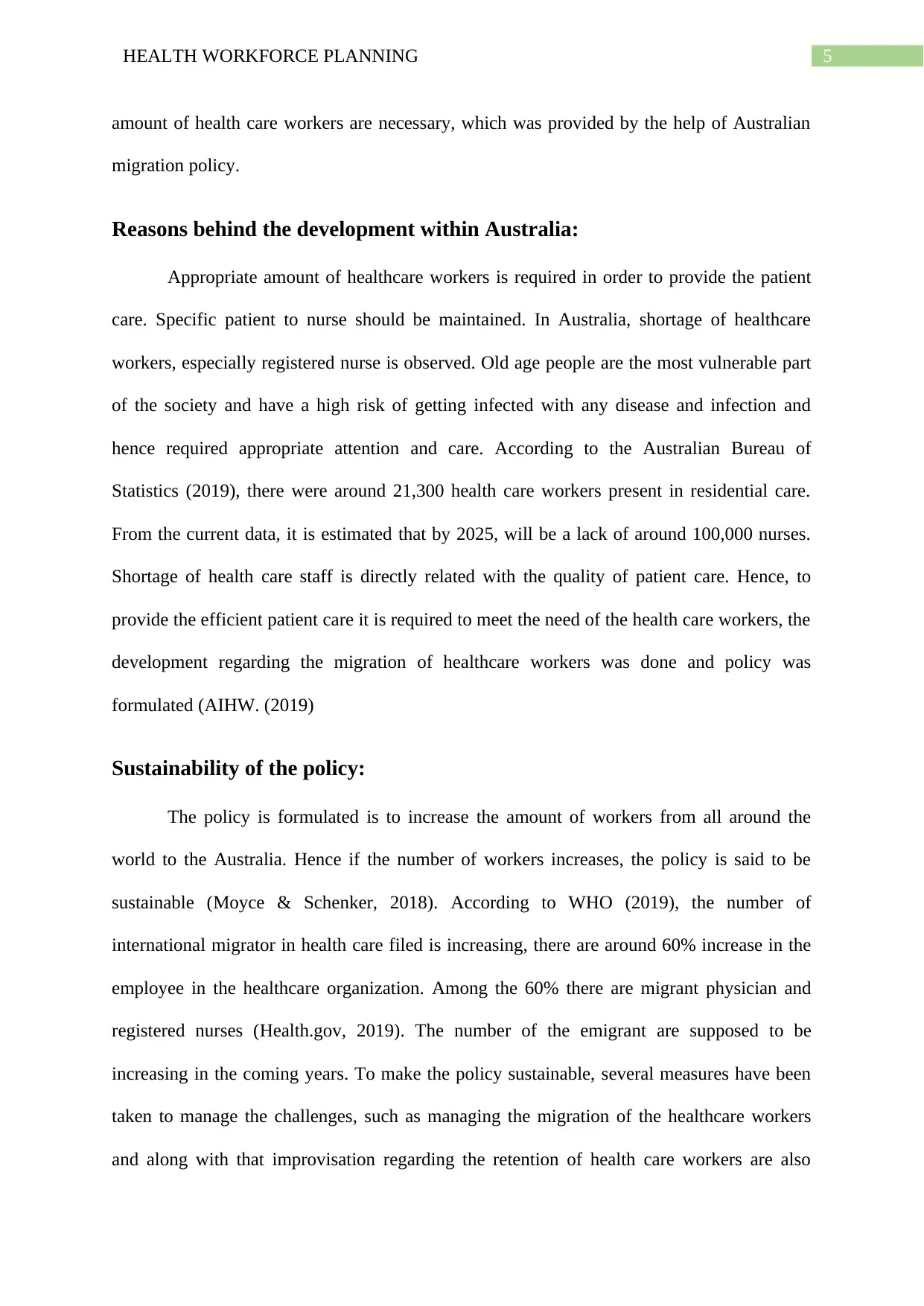
5HEALTH WORKFORCE PLANNING
amount of health care workers are necessary, which was provided by the help of Australian
migration policy.
Reasons behind the development within Australia:
Appropriate amount of healthcare workers is required in order to provide the patient
care. Specific patient to nurse should be maintained. In Australia, shortage of healthcare
workers, especially registered nurse is observed. Old age people are the most vulnerable part
of the society and have a high risk of getting infected with any disease and infection and
hence required appropriate attention and care. According to the Australian Bureau of
Statistics (2019), there were around 21,300 health care workers present in residential care.
From the current data, it is estimated that by 2025, will be a lack of around 100,000 nurses.
Shortage of health care staff is directly related with the quality of patient care. Hence, to
provide the efficient patient care it is required to meet the need of the health care workers, the
development regarding the migration of healthcare workers was done and policy was
formulated (AIHW. (2019)
Sustainability of the policy:
The policy is formulated is to increase the amount of workers from all around the
world to the Australia. Hence if the number of workers increases, the policy is said to be
sustainable (Moyce & Schenker, 2018). According to WHO (2019), the number of
international migrator in health care filed is increasing, there are around 60% increase in the
employee in the healthcare organization. Among the 60% there are migrant physician and
registered nurses (Health.gov, 2019). The number of the emigrant are supposed to be
increasing in the coming years. To make the policy sustainable, several measures have been
taken to manage the challenges, such as managing the migration of the healthcare workers
and along with that improvisation regarding the retention of health care workers are also
amount of health care workers are necessary, which was provided by the help of Australian
migration policy.
Reasons behind the development within Australia:
Appropriate amount of healthcare workers is required in order to provide the patient
care. Specific patient to nurse should be maintained. In Australia, shortage of healthcare
workers, especially registered nurse is observed. Old age people are the most vulnerable part
of the society and have a high risk of getting infected with any disease and infection and
hence required appropriate attention and care. According to the Australian Bureau of
Statistics (2019), there were around 21,300 health care workers present in residential care.
From the current data, it is estimated that by 2025, will be a lack of around 100,000 nurses.
Shortage of health care staff is directly related with the quality of patient care. Hence, to
provide the efficient patient care it is required to meet the need of the health care workers, the
development regarding the migration of healthcare workers was done and policy was
formulated (AIHW. (2019)
Sustainability of the policy:
The policy is formulated is to increase the amount of workers from all around the
world to the Australia. Hence if the number of workers increases, the policy is said to be
sustainable (Moyce & Schenker, 2018). According to WHO (2019), the number of
international migrator in health care filed is increasing, there are around 60% increase in the
employee in the healthcare organization. Among the 60% there are migrant physician and
registered nurses (Health.gov, 2019). The number of the emigrant are supposed to be
increasing in the coming years. To make the policy sustainable, several measures have been
taken to manage the challenges, such as managing the migration of the healthcare workers
and along with that improvisation regarding the retention of health care workers are also
⊘ This is a preview!⊘
Do you want full access?
Subscribe today to unlock all pages.

Trusted by 1+ million students worldwide
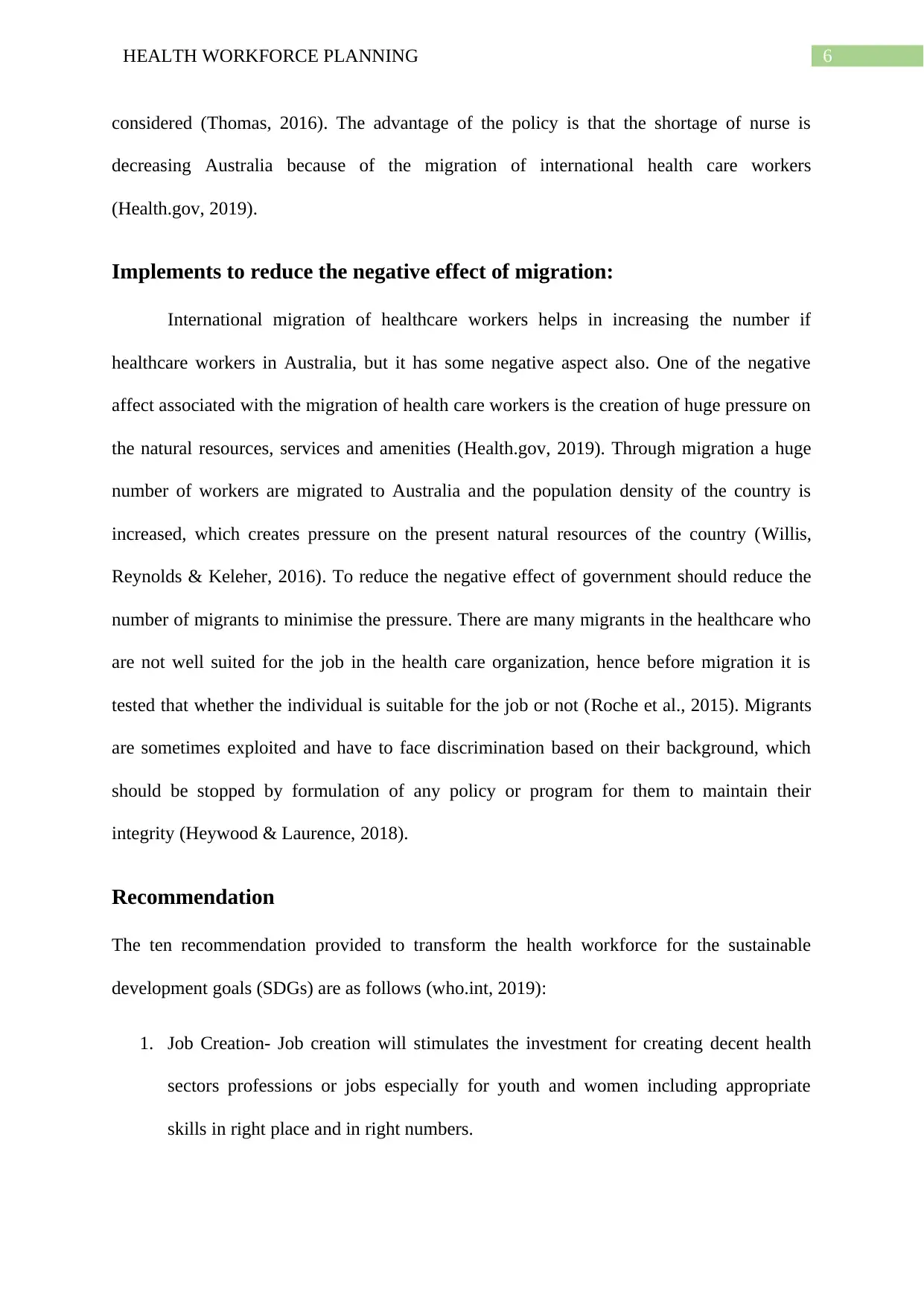
6HEALTH WORKFORCE PLANNING
considered (Thomas, 2016). The advantage of the policy is that the shortage of nurse is
decreasing Australia because of the migration of international health care workers
(Health.gov, 2019).
Implements to reduce the negative effect of migration:
International migration of healthcare workers helps in increasing the number if
healthcare workers in Australia, but it has some negative aspect also. One of the negative
affect associated with the migration of health care workers is the creation of huge pressure on
the natural resources, services and amenities (Health.gov, 2019). Through migration a huge
number of workers are migrated to Australia and the population density of the country is
increased, which creates pressure on the present natural resources of the country (Willis,
Reynolds & Keleher, 2016). To reduce the negative effect of government should reduce the
number of migrants to minimise the pressure. There are many migrants in the healthcare who
are not well suited for the job in the health care organization, hence before migration it is
tested that whether the individual is suitable for the job or not (Roche et al., 2015). Migrants
are sometimes exploited and have to face discrimination based on their background, which
should be stopped by formulation of any policy or program for them to maintain their
integrity (Heywood & Laurence, 2018).
Recommendation
The ten recommendation provided to transform the health workforce for the sustainable
development goals (SDGs) are as follows (who.int, 2019):
1. Job Creation- Job creation will stimulates the investment for creating decent health
sectors professions or jobs especially for youth and women including appropriate
skills in right place and in right numbers.
considered (Thomas, 2016). The advantage of the policy is that the shortage of nurse is
decreasing Australia because of the migration of international health care workers
(Health.gov, 2019).
Implements to reduce the negative effect of migration:
International migration of healthcare workers helps in increasing the number if
healthcare workers in Australia, but it has some negative aspect also. One of the negative
affect associated with the migration of health care workers is the creation of huge pressure on
the natural resources, services and amenities (Health.gov, 2019). Through migration a huge
number of workers are migrated to Australia and the population density of the country is
increased, which creates pressure on the present natural resources of the country (Willis,
Reynolds & Keleher, 2016). To reduce the negative effect of government should reduce the
number of migrants to minimise the pressure. There are many migrants in the healthcare who
are not well suited for the job in the health care organization, hence before migration it is
tested that whether the individual is suitable for the job or not (Roche et al., 2015). Migrants
are sometimes exploited and have to face discrimination based on their background, which
should be stopped by formulation of any policy or program for them to maintain their
integrity (Heywood & Laurence, 2018).
Recommendation
The ten recommendation provided to transform the health workforce for the sustainable
development goals (SDGs) are as follows (who.int, 2019):
1. Job Creation- Job creation will stimulates the investment for creating decent health
sectors professions or jobs especially for youth and women including appropriate
skills in right place and in right numbers.
Paraphrase This Document
Need a fresh take? Get an instant paraphrase of this document with our AI Paraphraser
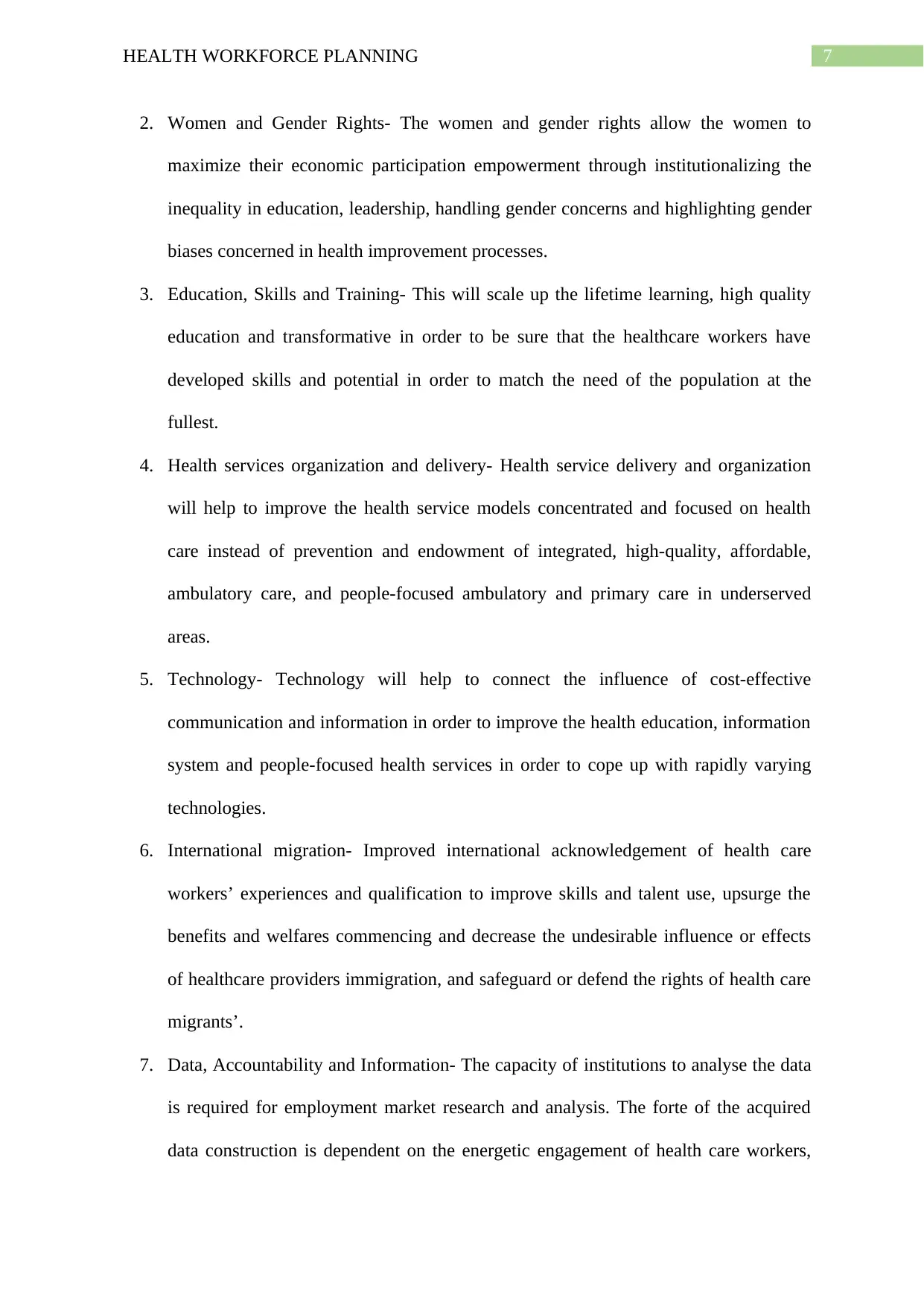
7HEALTH WORKFORCE PLANNING
2. Women and Gender Rights- The women and gender rights allow the women to
maximize their economic participation empowerment through institutionalizing the
inequality in education, leadership, handling gender concerns and highlighting gender
biases concerned in health improvement processes.
3. Education, Skills and Training- This will scale up the lifetime learning, high quality
education and transformative in order to be sure that the healthcare workers have
developed skills and potential in order to match the need of the population at the
fullest.
4. Health services organization and delivery- Health service delivery and organization
will help to improve the health service models concentrated and focused on health
care instead of prevention and endowment of integrated, high-quality, affordable,
ambulatory care, and people-focused ambulatory and primary care in underserved
areas.
5. Technology- Technology will help to connect the influence of cost-effective
communication and information in order to improve the health education, information
system and people-focused health services in order to cope up with rapidly varying
technologies.
6. International migration- Improved international acknowledgement of health care
workers’ experiences and qualification to improve skills and talent use, upsurge the
benefits and welfares commencing and decrease the undesirable influence or effects
of healthcare providers immigration, and safeguard or defend the rights of health care
migrants’.
7. Data, Accountability and Information- The capacity of institutions to analyse the data
is required for employment market research and analysis. The forte of the acquired
data construction is dependent on the energetic engagement of health care workers,
2. Women and Gender Rights- The women and gender rights allow the women to
maximize their economic participation empowerment through institutionalizing the
inequality in education, leadership, handling gender concerns and highlighting gender
biases concerned in health improvement processes.
3. Education, Skills and Training- This will scale up the lifetime learning, high quality
education and transformative in order to be sure that the healthcare workers have
developed skills and potential in order to match the need of the population at the
fullest.
4. Health services organization and delivery- Health service delivery and organization
will help to improve the health service models concentrated and focused on health
care instead of prevention and endowment of integrated, high-quality, affordable,
ambulatory care, and people-focused ambulatory and primary care in underserved
areas.
5. Technology- Technology will help to connect the influence of cost-effective
communication and information in order to improve the health education, information
system and people-focused health services in order to cope up with rapidly varying
technologies.
6. International migration- Improved international acknowledgement of health care
workers’ experiences and qualification to improve skills and talent use, upsurge the
benefits and welfares commencing and decrease the undesirable influence or effects
of healthcare providers immigration, and safeguard or defend the rights of health care
migrants’.
7. Data, Accountability and Information- The capacity of institutions to analyse the data
is required for employment market research and analysis. The forte of the acquired
data construction is dependent on the energetic engagement of health care workers,
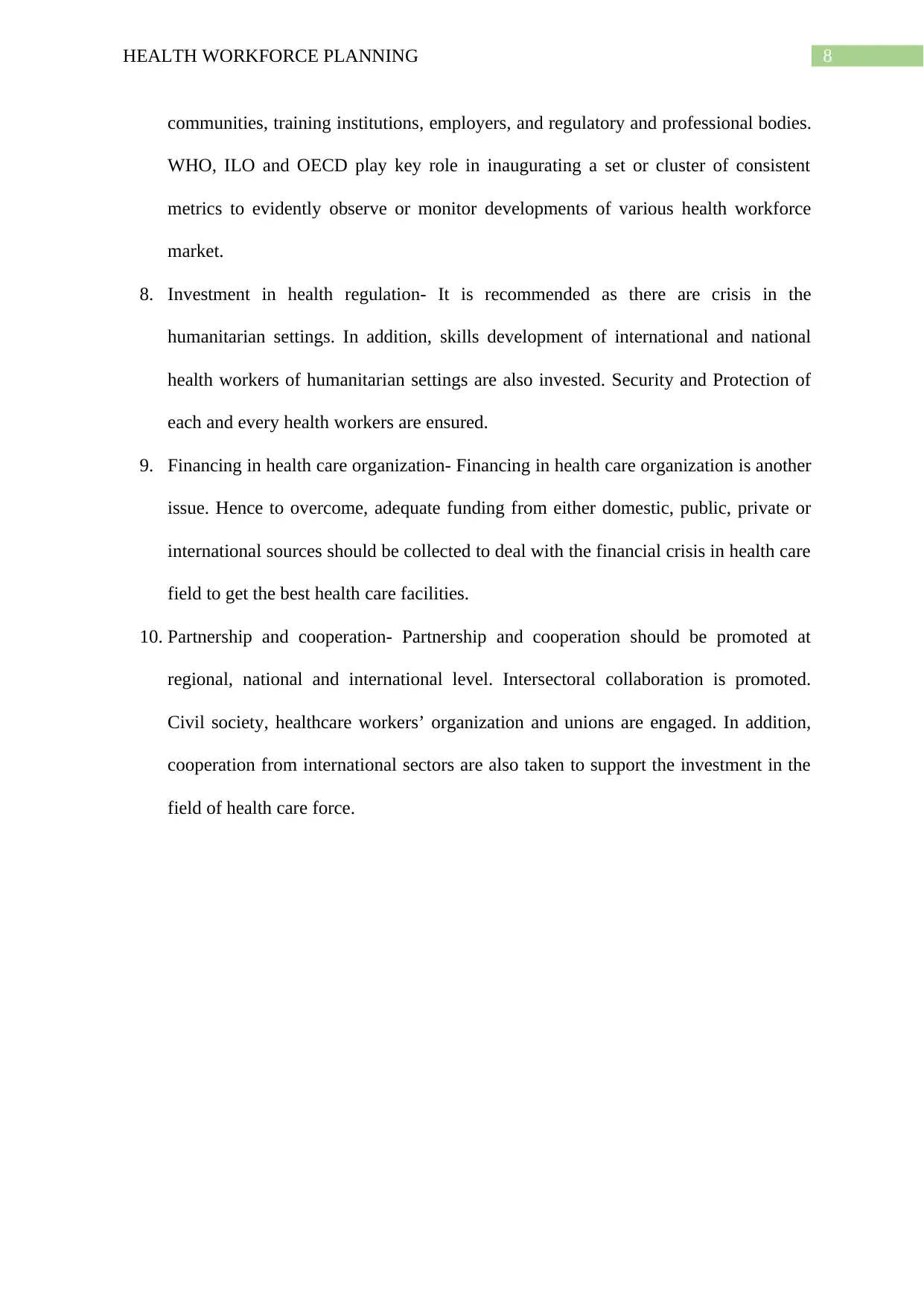
8HEALTH WORKFORCE PLANNING
communities, training institutions, employers, and regulatory and professional bodies.
WHO, ILO and OECD play key role in inaugurating a set or cluster of consistent
metrics to evidently observe or monitor developments of various health workforce
market.
8. Investment in health regulation- It is recommended as there are crisis in the
humanitarian settings. In addition, skills development of international and national
health workers of humanitarian settings are also invested. Security and Protection of
each and every health workers are ensured.
9. Financing in health care organization- Financing in health care organization is another
issue. Hence to overcome, adequate funding from either domestic, public, private or
international sources should be collected to deal with the financial crisis in health care
field to get the best health care facilities.
10. Partnership and cooperation- Partnership and cooperation should be promoted at
regional, national and international level. Intersectoral collaboration is promoted.
Civil society, healthcare workers’ organization and unions are engaged. In addition,
cooperation from international sectors are also taken to support the investment in the
field of health care force.
communities, training institutions, employers, and regulatory and professional bodies.
WHO, ILO and OECD play key role in inaugurating a set or cluster of consistent
metrics to evidently observe or monitor developments of various health workforce
market.
8. Investment in health regulation- It is recommended as there are crisis in the
humanitarian settings. In addition, skills development of international and national
health workers of humanitarian settings are also invested. Security and Protection of
each and every health workers are ensured.
9. Financing in health care organization- Financing in health care organization is another
issue. Hence to overcome, adequate funding from either domestic, public, private or
international sources should be collected to deal with the financial crisis in health care
field to get the best health care facilities.
10. Partnership and cooperation- Partnership and cooperation should be promoted at
regional, national and international level. Intersectoral collaboration is promoted.
Civil society, healthcare workers’ organization and unions are engaged. In addition,
cooperation from international sectors are also taken to support the investment in the
field of health care force.
⊘ This is a preview!⊘
Do you want full access?
Subscribe today to unlock all pages.

Trusted by 1+ million students worldwide
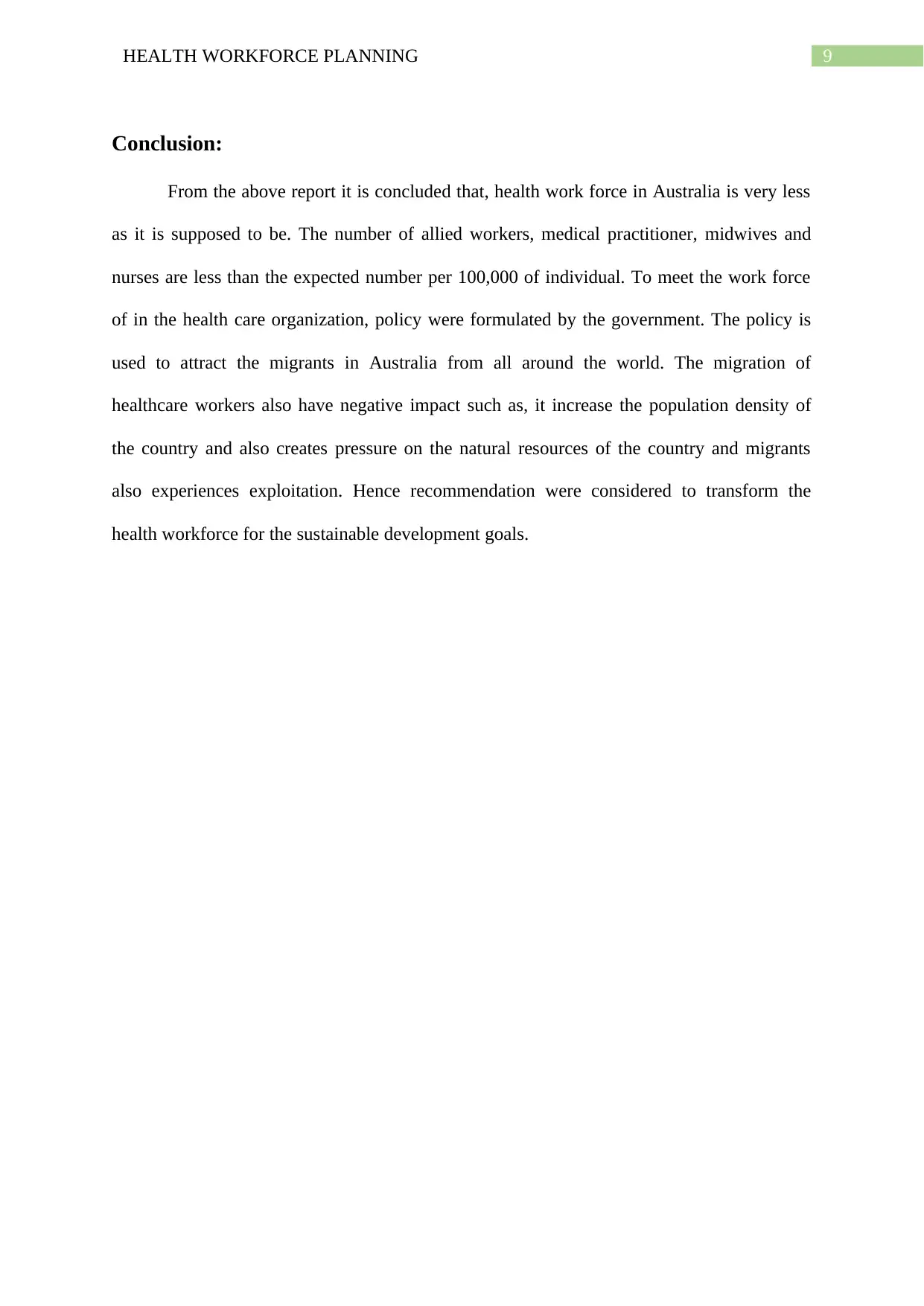
9HEALTH WORKFORCE PLANNING
Conclusion:
From the above report it is concluded that, health work force in Australia is very less
as it is supposed to be. The number of allied workers, medical practitioner, midwives and
nurses are less than the expected number per 100,000 of individual. To meet the work force
of in the health care organization, policy were formulated by the government. The policy is
used to attract the migrants in Australia from all around the world. The migration of
healthcare workers also have negative impact such as, it increase the population density of
the country and also creates pressure on the natural resources of the country and migrants
also experiences exploitation. Hence recommendation were considered to transform the
health workforce for the sustainable development goals.
Conclusion:
From the above report it is concluded that, health work force in Australia is very less
as it is supposed to be. The number of allied workers, medical practitioner, midwives and
nurses are less than the expected number per 100,000 of individual. To meet the work force
of in the health care organization, policy were formulated by the government. The policy is
used to attract the migrants in Australia from all around the world. The migration of
healthcare workers also have negative impact such as, it increase the population density of
the country and also creates pressure on the natural resources of the country and migrants
also experiences exploitation. Hence recommendation were considered to transform the
health workforce for the sustainable development goals.
Paraphrase This Document
Need a fresh take? Get an instant paraphrase of this document with our AI Paraphraser
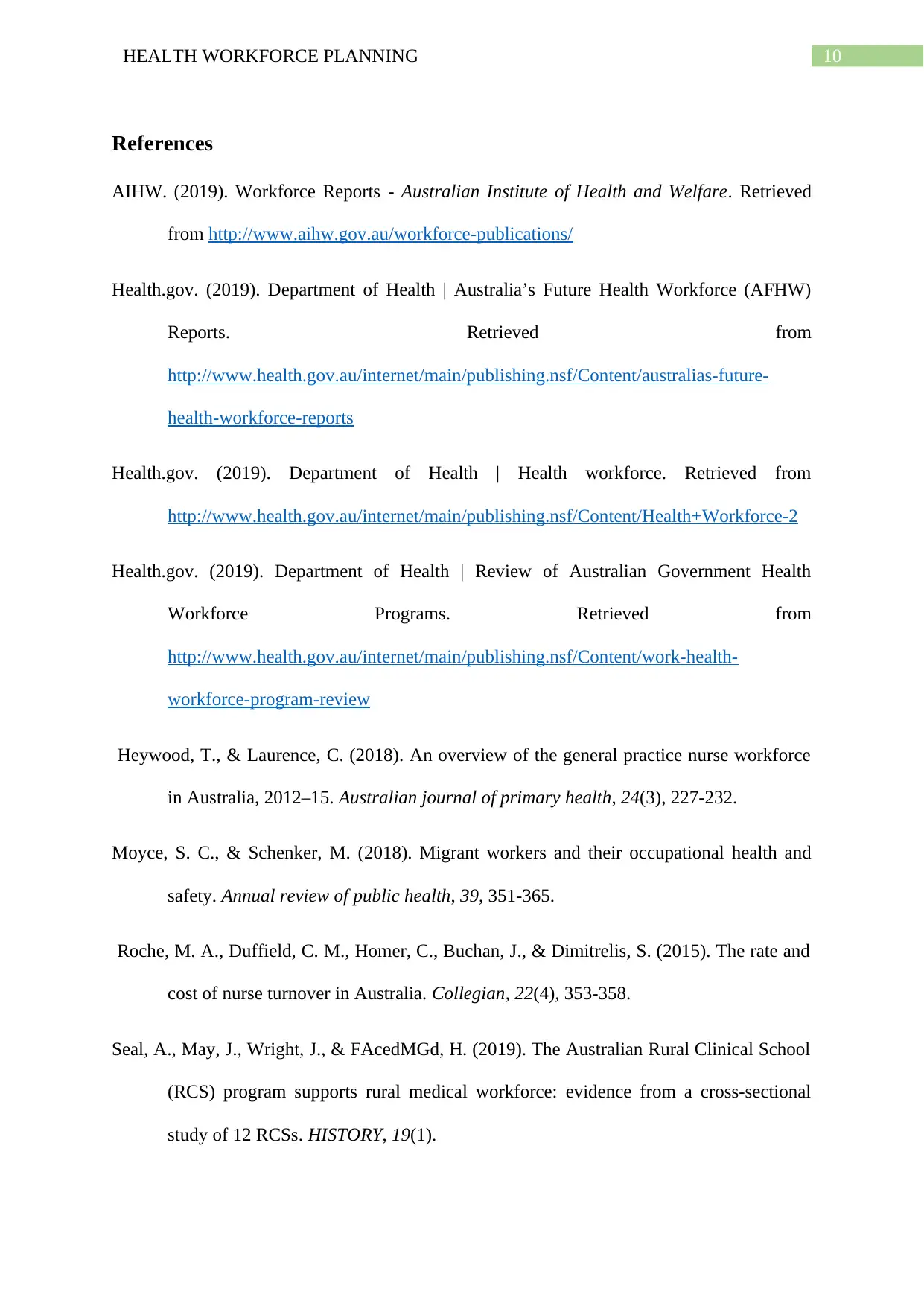
10HEALTH WORKFORCE PLANNING
References
AIHW. (2019). Workforce Reports - Australian Institute of Health and Welfare. Retrieved
from http://www.aihw.gov.au/workforce-publications/
Health.gov. (2019). Department of Health | Australia’s Future Health Workforce (AFHW)
Reports. Retrieved from
http://www.health.gov.au/internet/main/publishing.nsf/Content/australias-future-
health-workforce-reports
Health.gov. (2019). Department of Health | Health workforce. Retrieved from
http://www.health.gov.au/internet/main/publishing.nsf/Content/Health+Workforce-2
Health.gov. (2019). Department of Health | Review of Australian Government Health
Workforce Programs. Retrieved from
http://www.health.gov.au/internet/main/publishing.nsf/Content/work-health-
workforce-program-review
Heywood, T., & Laurence, C. (2018). An overview of the general practice nurse workforce
in Australia, 2012–15. Australian journal of primary health, 24(3), 227-232.
Moyce, S. C., & Schenker, M. (2018). Migrant workers and their occupational health and
safety. Annual review of public health, 39, 351-365.
Roche, M. A., Duffield, C. M., Homer, C., Buchan, J., & Dimitrelis, S. (2015). The rate and
cost of nurse turnover in Australia. Collegian, 22(4), 353-358.
Seal, A., May, J., Wright, J., & FAcedMGd, H. (2019). The Australian Rural Clinical School
(RCS) program supports rural medical workforce: evidence from a cross-sectional
study of 12 RCSs. HISTORY, 19(1).
References
AIHW. (2019). Workforce Reports - Australian Institute of Health and Welfare. Retrieved
from http://www.aihw.gov.au/workforce-publications/
Health.gov. (2019). Department of Health | Australia’s Future Health Workforce (AFHW)
Reports. Retrieved from
http://www.health.gov.au/internet/main/publishing.nsf/Content/australias-future-
health-workforce-reports
Health.gov. (2019). Department of Health | Health workforce. Retrieved from
http://www.health.gov.au/internet/main/publishing.nsf/Content/Health+Workforce-2
Health.gov. (2019). Department of Health | Review of Australian Government Health
Workforce Programs. Retrieved from
http://www.health.gov.au/internet/main/publishing.nsf/Content/work-health-
workforce-program-review
Heywood, T., & Laurence, C. (2018). An overview of the general practice nurse workforce
in Australia, 2012–15. Australian journal of primary health, 24(3), 227-232.
Moyce, S. C., & Schenker, M. (2018). Migrant workers and their occupational health and
safety. Annual review of public health, 39, 351-365.
Roche, M. A., Duffield, C. M., Homer, C., Buchan, J., & Dimitrelis, S. (2015). The rate and
cost of nurse turnover in Australia. Collegian, 22(4), 353-358.
Seal, A., May, J., Wright, J., & FAcedMGd, H. (2019). The Australian Rural Clinical School
(RCS) program supports rural medical workforce: evidence from a cross-sectional
study of 12 RCSs. HISTORY, 19(1).
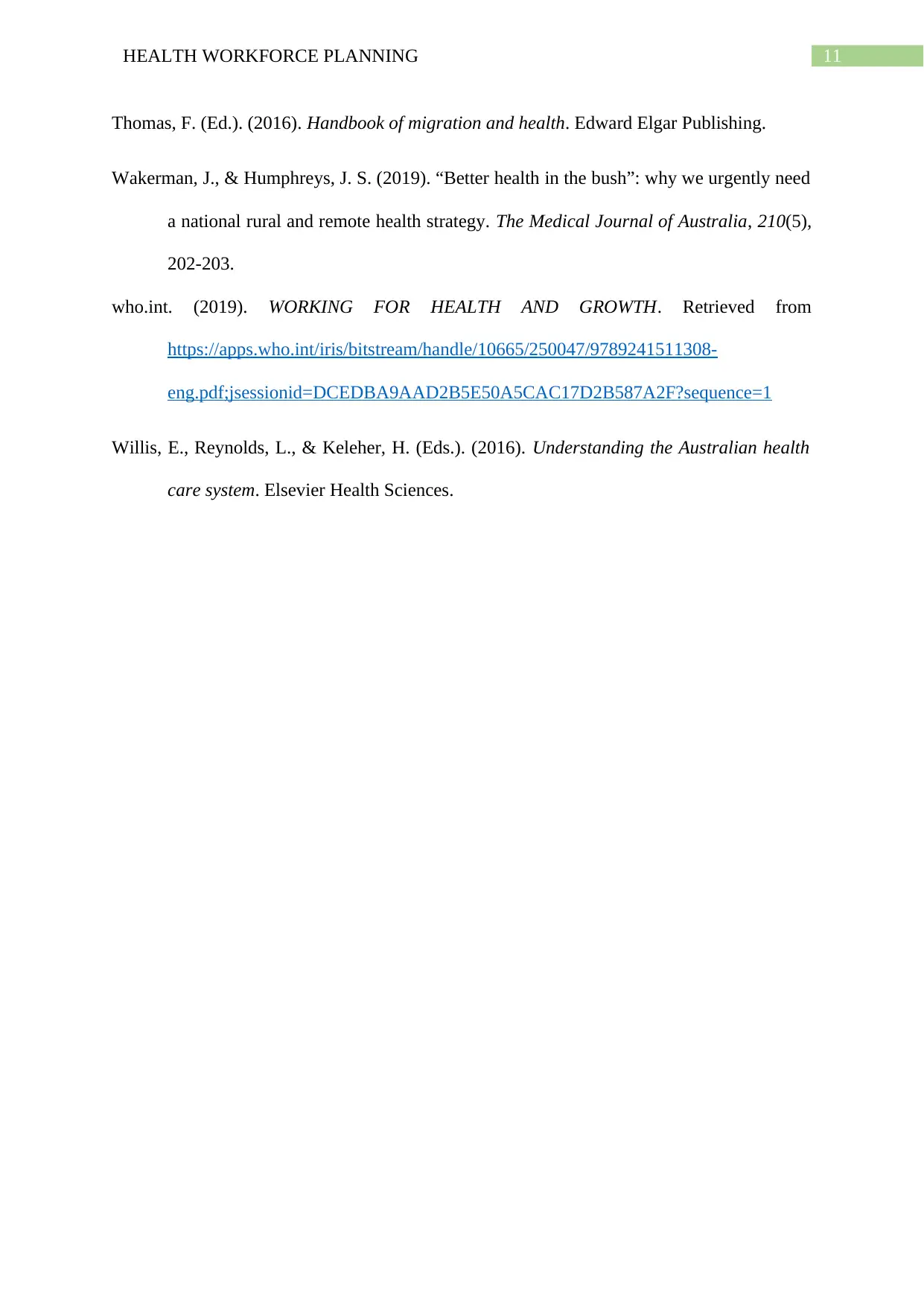
11HEALTH WORKFORCE PLANNING
Thomas, F. (Ed.). (2016). Handbook of migration and health. Edward Elgar Publishing.
Wakerman, J., & Humphreys, J. S. (2019). “Better health in the bush”: why we urgently need
a national rural and remote health strategy. The Medical Journal of Australia, 210(5),
202-203.
who.int. (2019). WORKING FOR HEALTH AND GROWTH. Retrieved from
https://apps.who.int/iris/bitstream/handle/10665/250047/9789241511308-
eng.pdf;jsessionid=DCEDBA9AAD2B5E50A5CAC17D2B587A2F?sequence=1
Willis, E., Reynolds, L., & Keleher, H. (Eds.). (2016). Understanding the Australian health
care system. Elsevier Health Sciences.
Thomas, F. (Ed.). (2016). Handbook of migration and health. Edward Elgar Publishing.
Wakerman, J., & Humphreys, J. S. (2019). “Better health in the bush”: why we urgently need
a national rural and remote health strategy. The Medical Journal of Australia, 210(5),
202-203.
who.int. (2019). WORKING FOR HEALTH AND GROWTH. Retrieved from
https://apps.who.int/iris/bitstream/handle/10665/250047/9789241511308-
eng.pdf;jsessionid=DCEDBA9AAD2B5E50A5CAC17D2B587A2F?sequence=1
Willis, E., Reynolds, L., & Keleher, H. (Eds.). (2016). Understanding the Australian health
care system. Elsevier Health Sciences.
⊘ This is a preview!⊘
Do you want full access?
Subscribe today to unlock all pages.

Trusted by 1+ million students worldwide
1 out of 12
Related Documents
Your All-in-One AI-Powered Toolkit for Academic Success.
+13062052269
info@desklib.com
Available 24*7 on WhatsApp / Email
![[object Object]](/_next/static/media/star-bottom.7253800d.svg)
Unlock your academic potential
Copyright © 2020–2025 A2Z Services. All Rights Reserved. Developed and managed by ZUCOL.





